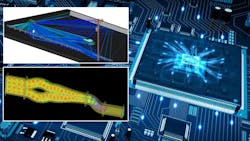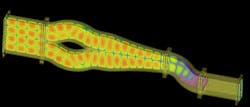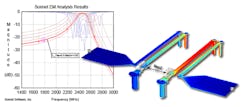RF/mmWave Design Tools Cut Prototyping Costs
Members can download this article in PDF format.
What you’ll learn:
- Selecting a CAD software program requires some work to narrow the field.
- Simulation and analysis software can operate from component to system levels.
- Models for design tools of choice can be had from engineering firms specializing in simulation model development and validation.
High-frequency design tools are evolving much like the computers that run them, growing in performance and versatility over time. As electronic applications continue to consume frequency spectrum, use of millimeter-wave (mmWave) frequencies is becoming more common, as in advanced driver-assistance system (ADAS) radars and 5G wireless communications systems. Thus, more components and devices are needed to support mmWave applications.
Computer-aided-design (CAD) software tools help create innovative designs at higher frequencies, modeling the behavior of components, devices, printed circuit boards (PCBs), and systems before expensive mistakes can be made. The latest high-frequency CAD tools support models well into the mmWave range (30 to 300 GHz), enabling simulation of a design’s performance whether at component, device, circuit, or even system level.
Selecting a CAD software program from the many available choices requires some work to narrow the field. Many CAD software programs are based on analysis of the electromagnetic (EM) fields around a conducting structure, such as a solder joint or transmission line, by solving Maxwell’s equations. They can be used at component, circuit, or system level for simulations.
Some simulators are geared for only one type of component, such as antennas or filters. While they’re easy to operate and can speed the design of a specific component, they fall short for many simulation chores such as modeling PCBs and systems.
Anticipation of future needs also should be part of this sorting process. A 3D EM simulator may enable precise visualization of the EM fields around different antenna structures within the RF/microwave frequency range. However, it may lack the accuracy and resolution to simulate the EM fields generated by an antenna design meant for the smaller wavelengths at mmWave frequencies.
In addition, connectivity is an important capability between and among modern CAD software tools. The usefulness of an EM simulator that can accelerate the design of a compact antenna is extended even further when the files or models representing the antenna are compatible with a system-level CAD simulator. It helps define the requirements for other components within the system, such as power amplifiers (PAs) and low-noise amplifiers (LNAs).
Component Considerations
Models created by CAD design tools often consist of device parameters, such as scattering (S) parameters, or Spice parameters, so that they can be interchanged from one software design tool to the next. When sorting through the large number of RF design tools on the market, model compatibility is essential if component models, such as filters and oscillators, will be part of a system-level simulation of a receiver using those filters and oscillators (along with many other component models).
Even at the component level, a voltage-controlled oscillator (VCOs) may consist of several transistors and a varactor diode to change the component’s frequency as a function of tuning voltage. Each of the VCO’s component parts is a separate model. The multiple models must work together so that the simulated performance of the combination tracks an amplitude-vs.-frequency plot of the measured performance of a VCO constructed from those same building blocks.
While suppliers of CAD design tools attempt to back their simulators with comprehensive model libraries, new RF/microwave components are introduced almost daily. Building accurate models takes time to match simulated performance to measurements of the new component—CAD software suppliers can’t be expected to keep track of every new IC and component on the market.
Fortunately, CAD tools from many major suppliers are backed by companies specializing in software models compatible with individual circuit simulators and full CAD software suites. This helps facilitate the pursuit for the best models for a simulation.
Start the Search
Ansys
Selecting software simulation tools takes some time at Ansys, perhaps best known by RF/microwave designers for its High-Frequency Structure Simulator (HFSS) full-wave 3D EM simulation software. The software simulates the behavior of high-frequency components, PCBs, and multifunction subsystems. However, it’s only one of 80 software tools available from the company to handle tasks such as mechanical and structural analysis, fluid dynamics, lightning analysis, material analysis, and thermal-management analysis and optimization.
Starting several decades ago as Ansoft, with Ansoft Designer schematic-capture software and HFSS EM simulation software, Ansys has grown into a global force for EM simulation with a wide range of design tools for different markets, including high-frequency electronics. Among its software tools are Ansys Maxwell for 2D and 3D EM and electromechanical analysis, and Ansys Multiphysics for thermal management and analysis.
To help those starting out with CAD software tools, Ansys has enjoyed a 40-year partnership with SimuTech Group. The latter provides engineering support and guidance starting from software installation on a PC.
One software tool of interest to RF/microwave designers is Ansys Discovery, a simulation-driven 3D EM software simulator available on a free trial basis (see "Free Software Tools: Try Before You Buy" at the end of the article). Another is Ansys SIWave, which simplifies the analysis and simulation of the signal-integrity (SI) and electromagnetic-interference (EMI) behaviors of electronic packages and PCBs.
For filter designers, Ansys Nuhertz FilterSolutions software provides automated RF/microwave and digital filter design, synthesis, and optimization. The filter design software interacts with Ansys HFSS to automatically provide on-screen controls for EM analysis and optimization of a design created in Nuhertz FilterSolutions.
For those hoping to expand high-frequency simulations from component to circuit to system levels, the Ansys Electronics Desktop integrates EM, circuit, and system simulation into a single user interface. Free downloads are available for students to help new users apply EM simulations during different design phases.
Cadence Design Systems
Cadence Design Systems, a long-time supplier of digital circuit design tools, supports high-frequency circuit and system designers with a wide range of EM-analysis-based software tools. The company’s AWR Design Environment platform provides the multiple function integration of its many software tools needed to synthesize, simulate, and optimize complete communications and radar systems at microwave and mmWave frequencies, from component through system stages.
The platform links the versatile AWR Microwave Office component and circuit simulator with programs such as the AWR Visual System Simulator (VSS), which models interconnected analog and digital components and subsystems. The VSS software provides time-domain, frequency-domain, and circuit-envelope analyses, and is an effective tool for performing baseband-through-RF/microwave system analysis of receivers, transmitters, and antenna arrays. It also adheres to mechanical design constraints that may impact a manufacturing process.
Additional Cadence EM-based design tools include the AWR AXIEM 3D planar method-of-moments (MoM) analysis and simulation software and the AWR Analyst 3D finite-element-method (FEM) software. These programs analyze the physical side of an electronic design, e.g., packaging and placement on a PCB, and how physical characteristics impact electrical behavior, e.g., EMI and electromagnetic compatibility (EMC). AWR AXIEM performs 3D planar EM analysis and simulation of passive antennas and transmission lines, while AWR Analyst analyzes and optimizes 3D structures and interconnections in high-frequency analog and high-speed digital designs.
For high-frequency circuit and component designers, Cadence offers the Spectre RF Option to both its Spectre X simulator and its Spectre Accelerated Parallel Simulator (APS) tools. The Option features several simulation engines, including shooting Newton, harmonic balance, and frequency-domain (FD) solvers, enabling a user to choose the best approach for a simulation, such as when optimizing oscillator phase noise. It works with the Cadence Virtuoso RF Solution to handle simulations of RF/microwave circuits and subsystem modules.
COMSOL
COMSOL Multiphysics from COMSOL Inc. is a far-reaching software design tool that attempts to include as many variables as possible when analyzing a circuit or component. The company recently released its latest version, 6.1. The software includes the RF Module program with multiple solvers for EM simulations.
Among the solvers, finite-element-method (FEM) techniques are typically used for higher-frequency simulations, but the tool also uses frequency-domain (FD) and time-domain (TD) solvers. Simulations couple physics effects, device surface deformations, material properties, thermal effects, and other variables.
A process known as adaptive meshing is used, in which mesh elements of many shapes (such as pyramids) and sizes subdivide a component under study into small sections to analyze how they will react to an EM field. The RF Module relies on accurate models to simulate and optimize RF, microwave, mmWave, and photonic designs.
Keysight Technologies
Keysight Technologies brings an abundance of RF/microwave measurement capabilities to its family of RF/microwave CAD tools. If a single word could best describe the strength of its software tools, it would be “connectivity” for the almost unlimited capabilities of enhancing and verifying simulations with measurements to aid in speeding design and optimization processes.
The collection of PathWave software tools enable circuit- and system-level simulations at RF through mmWave frequencies with PathWave System Design (formerly SystemVue software). They also provide access to programming for automatic testing aligned with CAD simulations via PathWave Vector Signal Analysis (VSA) software. The simulators are backed by large libraries of reference designs based on measurement data from the company’s highly accurate test instruments.
Other PathWave software tools include:
- PathWave Advanced Design System (ADS) for higher-level system simulations, such as combining modules developed in PathWave System Design.
- PathWave RFIC Design for frequency- and time-domain analyses of semiconductor devices and integrated circuits (ICs).
- PathWave EM Design for EM simulations.
- PathWave RF Synthesis (the former Genesys software).
Designs developed in PathWave RFIC also are compatible with the Cadence Virtuoso design environment from Cadence Design Systems and the Custom Compiler design environment from Synopsys.
MathWorks
Mathematics is the formula for building accurate RF models from available data, such as transistor S-parameters or transmission-line dimensions. On that front, MATLAB system-level software from MathWorks is probably the most well-known and widely used math-based simulation and design tool available. It provides the analysis and visualization capabilities to explore design models, including PCBs, prior to prototyping to save manufacturing time and expenses (Fig. 1).
The system-level software includes RF Toolbox with applications for designing, modeling, analyzing, and visualizing networks formed of RF/microwave components. It’s well-suited for modeling wireless communications and radar systems and can perform signal-integrity analysis of simulated received and transmitted signals.
One application in RF Toolbox, the RF Budget Analyzer, makes it possible to analyze transceiver signal chains for noise, power, and nonlinearity and generate RF Blockset models that simulate signal envelope behavior. The RF Toolbox also provides the capability to transform model formats, such as S-parameter models to Spice netlists, for compatibility when using MATLAB models in other simulators.
Remcom
XFdtd 3D EM simulation software from Remcom visualizes EM fields around a structure (Fig. 2) by solving Maxwell’s equations in the time domain rather than the frequency domain. It uses a unique finite-difference-time-domain (FDTD) solver approach with space divided into box-shaped cells minute enough to resolve dimensions at mmWave frequency wavelengths. The EM field around a structure is analyzed in these small sections and calculated in discrete steps.
The software has been used to simulate everything from antennas and oscillators to complete receivers, modeling operation at frequencies well into the mmWave range. The company also offers WaveFarer radar simulation software for analysis of radar pulses through different media and material, a useful tool for developers of ADAS radars (Fig. 3).
Siemens EDA
When thermal management of a design is a concern, Siemens EDA offers FloTHERM thermal analysis and simulation software as part of its Simcenter integrated CAD environment. The company added the software, which aids in developing thermal-management solutions for PCBs, in its acquisition of Mentor Graphics.
The software is backed by large libraries of thermal models for a variety of materials employed in electronic designs. It incorporates efficient thermal-modeling techniques for thermal analysis and optimization, ensuring the highest temperature-related reliability possible for a design.
Sonnet Software
Sonnet Software is a company name that’s perhaps most synonymous with EM simulation. The firm’s Sonnet Suites performs 3D full-wave EM analyses of planar structures, such as PCBs, using Maxwell’s equations and MoM analysis routines to include all coupling and material effects within a simulation. The Sonnet Suites focuses on planar analysis to create accurate models of a structure or PCB at frequencies well into the terahertz range. The models are available in a variety of formats, including based on S-, Y-, and Z-parameters and even Spice simulation models.
A free version of the firm’s EM simulation software, Sonnet Lite, is downloadable from the website with easy-to-follow online tutorial lessons on using the software. Although scaled down compared to the comprehensive Sonnet Suites, Sonnet Lite (Fig. 4) and its newest version, Sonnet Lite Plus, can perform full-wave EM analysis of 3D planar circuits, such as microstrip or stripline filters and microstrip couplers, well into the mmWave frequency range.
Making Models
Many CAD tools feature generous libraries of component models that can be used as circuit building blocks, but the introduction of new electronic components occurs daily. Thus, it becomes difficult for every CAD tool provider to be up-to-date with models for all of the newest components. Fortunately, CAD software users often can obtain models supporting their design tools of choice from engineering firms specializing in simulation model development and validation.
For example, Coventor develops 3D device models based on different semiconductor processes, such as field-effect transistors (FETs), from a variety of suppliers. The active-device models are compatible with many EM simulators on the market. This is a result of Coventor working closely with each semiconductor supplier on acquiring S-parameters and other parameters to build a model that will provide simulation results closely matched to measurements of the physical device.
One of the best-known CAD simulation model suppliers is Modelithics, with models for most of the major RF/microwave design and simulation tools. The Modelithics Library for Cadence Spectre RF Option is available with a mmWave and 5G library, where component models have been validated to 30 GHz, some to as high as 125 GHz (Fig. 5). The sub libraries can be specified for components from a single vendor or from multiple vendors to enhance design flexibility.
The Modelithics COMPLETE Library for Sonnet Suites also provides a diversity of sub libraries, including for die, surface-mount components, and devices validated at mmWave frequencies. The company supports most of the major RF software tools with extensive component model libraries, including RF/microwave inductor-resistor-capacitor (LCR) model libraries.
Some software design tools focus on the design and simulation of a single component or type of component, such as filters or antennas. Take PCAAD 7.0 from Antenna Design Associates, which is the latest version of an antenna design and simulation program for the Microsoft Windows OS, in particular Windows 7 and 10. The easy-to-follow, menu-driven software models microstrip antennas, arrays, wire antennas, and other forms of antennas with more than 50 built-in design routines.
Another “single-purpose” software design tool, HFWorks from EMWorks Inc., is an 3D EM simulator that’s nominally for antenna design but also can be used to analyze high-frequency thermal effect, resonators, and high-speed digital interconnections. It features an integrated electro-thermal analysis tool that predicts the effects of input power on the resulting temperature of a design.
ICAP/4Rx RF Deluxe from Intusoft is a design and simulation suite of modeling tools for designs within the RF range to about 200 MHz. It’s well-endowed with thousands of dedicated models and is available in a Windows version with added design verification capability.
Finally, SoftWright LLC’s TAP 7.6 Terrain Analysis Package (TAP), which is not quite modeling a communications system but related to how it works, provides RF signal-path analysis for point-to-multipoint wireless networks over a wide range of terrain models. It can be modified as needed to simulate how a communications system is expected to perform across different areas.
Free Software Tools: Try Before You Buy
No-cost trial versions of RF/microwave design tools offer painless ways to explore a software simulator’s capabilities.
Learning whether an RF design tool is suitable for an application can be quite painless when taking advantage of free scaled-down versions or no-charge introductory trial periods of full-fledged software tools offered by many CAD software suppliers.
For example, Cadence has free trial versions of its AWR Design Environment, an assortment of design and simulation tools for RF/microwave projects at device, circuit, and system levels. When choosing a trial option, users can download trial versions optimized for RF/microwave component design, EM analysis for antenna design, and radar and communications design simulation at the system level.
PathWave System Design from Keysight Technologies, with a large library of measurement-proven reference designs, is available on a free trial basis, as is the company’s PathWave RFIC Design software for designing high-frequency ICs. MathWorks has a free trial version of its popular RF Toolbox software for the design and simulation of RF/microwave components for use in radar and communications systems.
In addition, Sonnet Lite and Sonnet Lite Plus are free, feature-limited versions of the popular suite of EM simulation tools from Sonnet Software, downloadable from the company’s website. For those interesting in learning more about very basic EM simulation and design, RFSim99 is a freeware RF design software tool that can be downloaded from the AD5GG website.
Beyond software developers, many high-frequency component and device suppliers provide free software tools on their websites, tailored to the use of their products.
Circuit designers using high-performance, low-loss circuit laminates for microwave transmission lines such as microstrip, stripline, and coplanar-waveguide (CPW) lines, can check out circuit material supplier Rogers Corp.’s free impedance calculator for transmission lines fabricated on its substrate materials. Analog Devices, a supplier of system-on-chip (SoC) and system-in-package (SiP) semiconductors, offers a variety of free software design tools from its online engineering design center in support of the company’s active devices.
For designers in need of crystal oscillators and other timing devices where minimizing jitter (or phase noise in the frequency domain) is essential, component and IC manufacturer Kyocera AVX recently announced a circuit matching service to identify the optimum timing device for a particular circuit design. The online tool matches a user’s requirements to components from 40 different global suppliers of oscillators and timing devices, including a detailed report covering key performance parameters like startup time, drive level, and initial frequency deviations.
In addition, Kyocera AVX offers many RF component design tools and provides free libraries of S-parameters and other simulation model parameters for its components, compatible with Ansys HFSS and many other RF design tools.
About the Author
Jack Browne
Technical Contributor
Jack Browne, Technical Contributor, has worked in technical publishing for over 30 years. He managed the content and production of three technical journals while at the American Institute of Physics, including Medical Physics and the Journal of Vacuum Science & Technology. He has been a Publisher and Editor for Penton Media, started the firm’s Wireless Symposium & Exhibition trade show in 1993, and currently serves as Technical Contributor for that company's Microwaves & RF magazine. Browne, who holds a BS in Mathematics from City College of New York and BA degrees in English and Philosophy from Fordham University, is a member of the IEEE.





